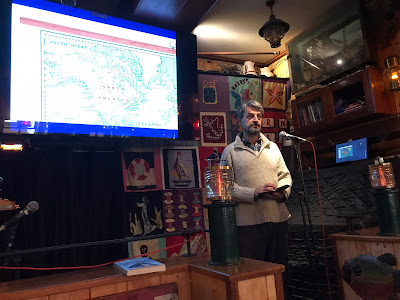In January 2019 Gina Koellner and I made a pilgrimage to the site of Goldner's preserved provisions manufactory.
The site is now partly occupied by a somewhat stern faced office building named Five Acre Square with the nominal street address of 133 Houndsditch.
Supimposing the footprint of the McCall & Co warehouse from Charles Goad's 1887 insurance map on a Google Maps image of the present day street layout shows how the new road, Stoney Lane, was driven through the site of the largest building in the range.
 |
| A different kitchen once occupied this spot |
 |
A cosy hostelry for City workers
|
The corner of the new building which overlies the Goldner site contains a bar called CBK, for City Bar and Kitchen. It would have been wrong to visit the location without popping in for a coffee, or a cheeky beer in my case.
 |
Illustrated London News, Page 93, 31 January 1852
|
The Illustrated London News paid their own visit in January 1852. Their article concluded:
Our sketch represents the establishment of Messrs. Ritchie and M'Call, of Houndsditch, whose preserved provisions are excellent, as we can testify from experience, having examined the contents of canisters taken at random from their stores.
The Parliamentary Inquiry reported that Thomas Thorp, who had been employed by Goldner at Galatz for five or six years, had stated that Goldner still had an interest in Ritchie's business.

The interior scene depicted exhibits quite a close correspondence with the plan of the Southern building in the complex. It should be remembered that the map is from many years later so it is likely that there may be some differences. I take the figures "1=2" in the corner to mean a single story building with the height equivalent to two stories. In other words, a double height space. The shaded rectangles in the corner are steam boilers, presumably to heat the preserving vats. The forty foot tall chimney shown in the plan was the cause of a notice of a nuisance complaint being issued in 1853 due to emission of opaque smoke. The proprietors promised to take greater care in feeding the furnace and no further action was taken.
Although not mentioned in the article, at the time of the ILN's visit, the three storey warehouse on the Northern side of the complex was in ruins as it had been
gutted by a fire in November 1851. Several local newspapers carried the
following report:
Fire at Aldgate Old Workhouse. — A
fire, attended with much destruction of valuable property, broke out
shortly after twelve o'clock on Saturday morning, in the immense range
of premises formerly Aldgate Workhouse, but at the present time in the
tenure of Messrs. Ritchie and M'Call, household provision manufacturers,
situate in Cock and Hoop-yard, Houndsditch. The flames originated from
some unknown cause in the staircase of the north wing, and very speedily
three of the floors became fired almost simultaneously, and for some
time nothing short of the complete destruction of the premises could
apprehended. Numerous engines of the London Brigade and West of England
Office, with the Royal Society's fire escapes, were remarkably early it
arriving, and no time was lost in setting the machinery to work, but, in
spite of the most strenuous exertion of the firemen, it was nearly
three o'clock before the fire could be extinguished. The damage done is
thus officially reported :— Three floors of warehouse and store rooms
burned out; greater part of roof burned off of one half of the north
wing. The floors adjoining, together with their contents, considerably
damaged by water, and the furniture in dwelling-houses by water and
removal. The building was insured in the Sun, and the contents in the
Phoenix offices.
The report of the Parliamentary Inquiry contains a record of the earliest documented visit to the factory at 137 Houndsditch although the author's imperfect memory substitutes Shoreditch for Houndsditch.
The witness, Commander George Farquhar Morice, RN 1792 - 1868, was Master Attendant of the Victualling Establishment Deptford from 1833 to 1850. He mentions two senior officers, William Henry Shirreff (1785–1847) and Sir John Hill (1774–1855), in charge of the Navy's most important victualling establishments at the time of the Franklin expedition. The fact that William Henry Shirreff retired in 1846 indicates that the visit must have been earlier than the five or six years remembered by Commander Morice in 1852. It seems a reasonable inference that the reason this inspection happened was connected with the provision of supplies for Franklin's ships.
The inevitability that Goldner's reputation would be destroyed had been predictable many months before January 1852 when the shocking revelations of the Navy's preserved meats scandal would erupt from the pages of The Times. Those months were not wasted: "Goldner's Patent" preserved provisions would be rebranded as Ritchie and McCall's. Ritchie would subsequently depart to set up a business in Australia leaving the business of McCall and Co. to thrive for nearly a century, being finally wound up on 14 April 1964. That is not the end of the story though as there was another business associated with Goldner which played a part in the production of the canned provisions for the Franklin expedition. Remarkably that business has survived to the present day with the most recent report of annual earnings being greater than 500 million US Dollars.
Comments are welcome here or on the Remembering the Franklin Expedition Facebook page.




































